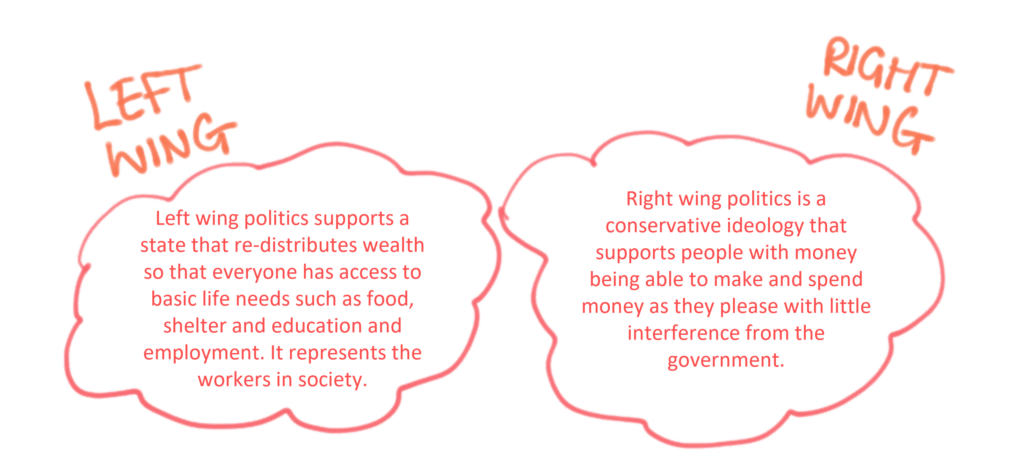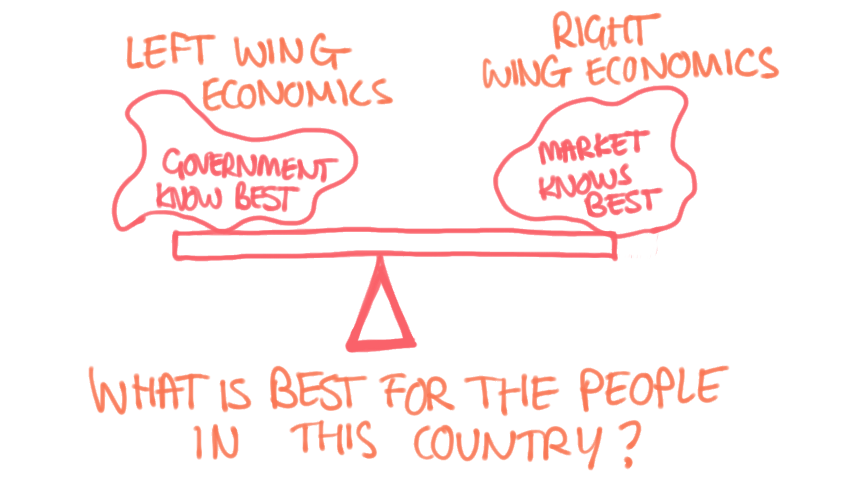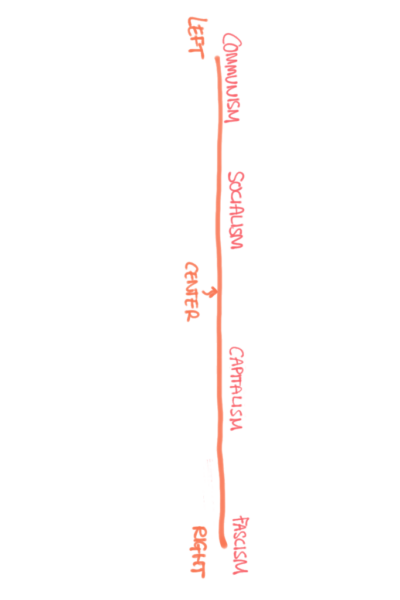Right wing, left wing, centre left, far right…what do these things mean in politics? This post gives a simple, intuitive view of what these words mean. It answers the questions: What does left/right wing mean? what are left/right economic policies? then, what is the political spectrum? and what do political parties represent?
What does right / left wing mean?
These are terms we’ve used for the last few hundred years to describe political groups. Society used to be made of aristocrats who owned land and property, and workers who worked for them. When, as time developed these workers finally got political representation they had very different interests to the aristocrats. They fought for workers right, proper wages and support form the government so everyone could afford basic things in life such as food and shelter. This was the left of the political spectrum. The Aristocrats, of course, did not want any of this. They didn’t want to give up any money to the government for support of the poor. They had no interest in paying higher wages- it was expensive to them. This was the right of the political spectrum.
Right wing politics is a conservative ideology that supports people with money being able to make and spend money as they please with little interference from the government. Left wing politics supports a state that re-distributes wealth so that everyone has access to basic life needs such as food, shelter and education and employment. As such, left wing politics represents the workers or the majority of the population.

What does left wing mean?
Left wing is a political stance that:
- Represents the interest of the majority of the population by creating good workers rights
- Has a high intervention from the state who re-distribute money. (They do this by taxing those with income and providing services to those in need)
- Believes in social security and welfare so that everyone has equal opportunities because they have equal access to food, shelter, education, healthcare etc.
What does right wing mean?
Right wing politics means:
- Protecting the traditional values of the upper classes
- Support free economics, and low intervention from government as they believe the government doesn’t work as well as ‘the market’
- Allows those with money to hold on to it, rather than taxing it. This means it can be invested in whatever the market recognises as valuable at that time.
What is right / left wing economics?
The argument between left and right wing economics is basically an argument between market power and governmental power.

The right believe that ‘the market’ should be allowed to function with no government intervention. The more freely it is allowed to operate, the more efficient it will be creating money for people. The people who earn money from the market (typically wealthy people) with spend this money in the economy, on things, or services. This creates the wage for all the workers. This is called trickle down. The more money available at the top (ie the more efficient the market), the more money will be able to trickle down and everyone will get richer. This was the key message of one of the most famous economists of all time, Adam Smith. He said that the market was most effective when it was left to its own devices with no intervention.
The left believe a free market does not always behave in a way to benefit the people of a society. They believe the government should plan a country’s economy so it creates the best life outcome for its people. A right-wing approach leads to a trickle-down system, however, at each stage some money is being taken away into private hands, so it never reaches the bottom of the pyramid in full (like you can see I’ve drawn in the picture below). The best outcome of life, involves a high level of societal care and shared, high quality infrastructure and services so that everyone can live with security of their health, job and knowing they will always have access to some sort of home and food for their families.
What is political spectrum?
You can draw left wing and right wing as either ends of a number line. At one extreme, far left, is a philosophy called communism (where everything in society is shared equally between everyone). On the left but close to the middle is an ideology called socialism. This advocates that people receive equal levels of high quality welfare but not that they share out everything equally.

The centre is a tricky place- lots of people call themselves centre, or centre-left or centre-right. However, since there’s no fixed number on that line there no way to define exactly what it means in political term. Everything is relative. More commonly in countries, centre comes to mean the middle point between the two main opposing political parties. In the UK, for example, that’s labour and the conservatives.
On the right is capitalism (in a more extreme form than most societies, where there is very little government intervention in the activities of the market). To the far right is nationalism and then fascism. Fascism is the idea that some people are born with a higher right to money and power, and a right to have other people work for them. This is dangerously often an opinion formed off race; that one race has moral superiority over another, such as the NAZI fascist regime that though Germans and Arians had authority over ethnic minorities, particularly Jews.
On the far left is an ideology called communism.
What do the political parties represent?
In the UK, the parties sit somewhere on the political spectrum drawn above. Labour represent the left and the Conservatives (the Tories) represent the right. The liberal democrats have a mix of policies. Some fall between the two parties, but a few fall left of labour (such as their philosophy on quality education). Further left of labour lies the green party. To the right of the conservatives lies UKIP the UK Independence party.
These are relative political positions. They shift about a bit depending on who is running the party at any given time. Check out this next post on actual political regimes and how they compare across countries and leaders.
Populism
Nowadays there is a new type of political divide emerging. It lies, not between rich and poor, but between traditional workers and modernly educated liberals. This divide is called populism. There’s another post about it here.
To conclude
The right/left wing divide is the most common language we use to describe political orientation. Generally the right is the party representing these with money. They protect their rights to do what they want with their money. The left generally represents the interest of the majority in the society. They believe there should be some re-distribution of money to afford basic life necessities. A good start to life for everyone (such as food, shelter, education, right to a job etc) will lead to more equal opportunity.
I hope this has helped, thanks for reading! This is a community to engage in understanding the systems in our world. We’re working towards a fairer, kinder, sustainable future. Join our monthly mailing list and hear about what’s been published on the site and what’s been going on.

